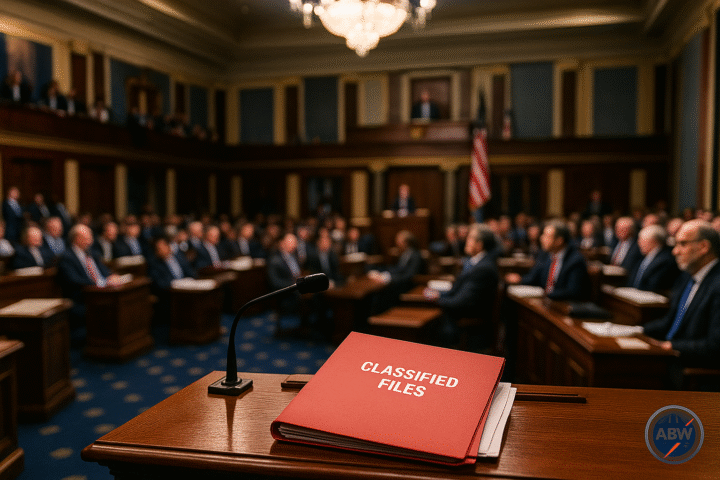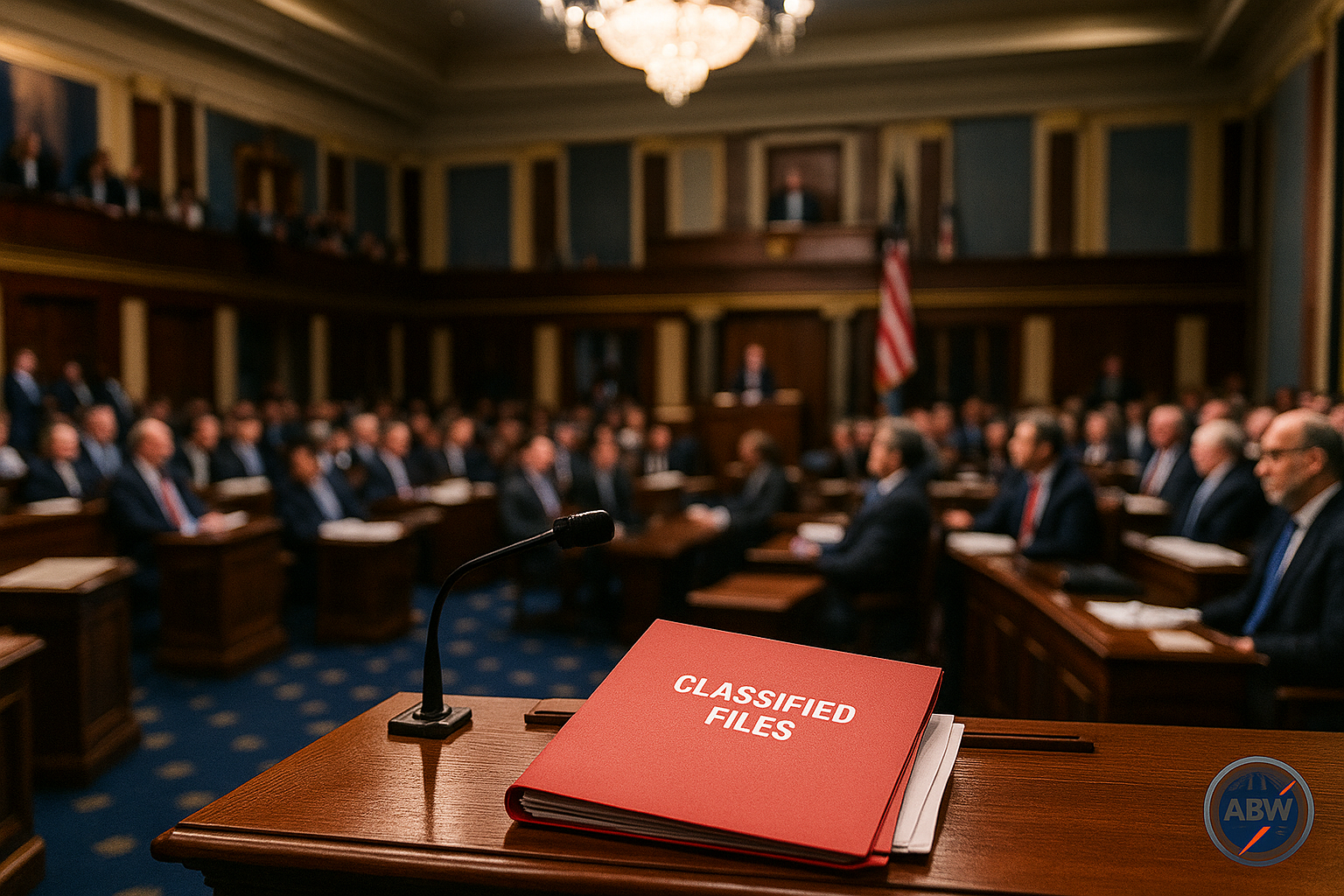Epstein files release has exploded into one of the most contentious political and legal fights in Washington, bringing together newly disclosed emails about Donald Trump, a rare congressional procedure known as a discharge petition, and long-running questions about justice for Jeffrey Epstein’s victims.
In the span of just a few days, lawmakers released more than 20,000 pages of documents from Epstein’s estate, including emails in which the convicted sex offender claimed he knew “how dirty Donald is” and boasted that he was “the one able to take him down.” Politico+1
The White House, for its part, has dismissed the uproar, branding the fresh disclosures as a “hoax” and insisting the emails “prove literally nothing.” The Guardian+1
Yet pressure is building in Congress. A bipartisan group of lawmakers has now secured enough signatures to force a vote on compelling the Justice Department to release all remaining Epstein files, subject to protections for victims’ identities. Reuters+2The Washington Post+2
This is no longer just a story about one disgraced financier. It is about transparency, political power, and whether the public will ever see the full record of Epstein’s dealings with some of the world’s most influential people.
The New Document Dump: What’s Actually in the Epstein Files?
The latest cache of material – more than 20,000 pages of documents, images and emails – comes on top of years of court filings, testimony and investigative reporting about Jeffrey Epstein’s sex-trafficking network. This new release, however, is the most extensive trove yet from his estate handed to Congress. The Guardian+1
Much of the public focus has narrowed onto a handful of emails in which Epstein discusses Donald Trump, Prince Andrew (Andrew Mountbatten-Windsor) and various journalists, lawyers and political insiders. The emails do not include any messages to or from Trump himself, and none of the freshly released documents accuse the former president of committing sexual abuse. Instead, they raise questions, hint at leverage and show Epstein trying to position himself as someone who knew a lot about powerful people – and wanted everyone else to know he knew.
Three email chains in particular have drawn the most attention:
- An April 2011 message to Ghislaine Maxwell in which Epstein refers to Trump as “the dog that hasn’t barked” and says that a victim “spent hours at my house with him.” ABC+1
- A 2015 exchange with journalist Michael Wolff in which Epstein tries to strategise about how Trump should answer questions on CNN regarding their relationship. The Independent+1
- A January 2019 email where Epstein asserts that “of course [Trump] knew about the girls,” claiming that Trump had asked Maxwell “to stop” – a statement that has not been independently corroborated. Politico+1
For Trump’s critics, these snippets suggest a much deeper awareness of Epstein’s conduct than the former president has publicly admitted. For his allies, they are nothing more than the boasts of a dead man, cherry-picked and weaponised by political opponents.
White House Response: ‘These Emails Prove Literally Nothing’
The Trump White House has moved quickly to contain the fallout. Officials have argued that the renewed focus on the Epstein files release is a politicised distraction from the administration’s agenda and its handling of the recent government shutdown. The Guardian+1
Press officials have hammered a set of talking points:
- The emails were not written by Trump, and do not show him committing a crime.
- Epstein was a proven liar and manipulator who may have exaggerated his knowledge for leverage.
- Democrats and “mainstream media” outlets are allegedly using the story as yet another “hoax” to damage the president. Fox News+1
Deputy press secretary Abigail Jackson reportedly summarised the White House’s view bluntly: “These emails prove literally nothing.”
At the same time, the administration has emphasized that one of Epstein’s most high-profile accusers, Virginia Giuffre, repeatedly said she never saw Trump engage in abuse and did not accuse him of wrongdoing. ABC+1
The strategy is clear: deny any substantive implications from the documents, highlight exculpatory statements from victims, and frame the episode as partisan theatre. Whether that strategy succeeds will depend less on the existing emails than on what, if anything, emerges from the next phase of the Epstein files release.
Epstein, Trump and the ‘Dog That Hasn’t Barked’
The most quoted line from the new tranche is the 2011 email where Epstein calls Trump “the dog that hasn’t barked.” In that message to Ghislaine Maxwell, he notes that a young woman – widely understood to be Virginia Giuffre – had “spent hours at my house with him” and yet “he has never once been mentioned.” ABC+1
That phrase has been interpreted in different ways:
- A sign of potential leverage: Epstein could be hinting that Trump, because of what he allegedly knew or did, might one day be forced to “bark” – to speak publicly about their shared history.
- A complaint about silence: Epstein may have felt Trump owed him public defence or loyalty and was irritated that his name had stayed out of the headlines.
- Bragging for effect: It’s also possible Epstein was simply flexing for Maxwell, reminding her that he had relationships with powerful men who, at least for the moment, remained quiet.
None of this proves criminal conduct by Trump. What it does reveal is how Epstein saw their dynamic: he believed Trump knew more than he was saying and that this silence itself had strategic value.
In a separate email years later, Epstein wrote that he “knew how dirty Donald is” and claimed that Trump “of course…knew about the girls.” The Independent+1 Again, these are Epstein’s words, not sworn testimony or corroborated evidence. But they are now lodged firmly in the middle of an already polarised fight over transparency.
The Andrew–Giuffre Photograph and Other High-Profile References
Not all of the newly released material relates to Trump. Another headline-grabbing email appears to confirm that the notorious photograph of Andrew Mountbatten-Windsor – the man formerly known as Prince Andrew – with his arm around a teenage Virginia Giuffre is genuine.
In an exchange from 2011, Epstein responds to a journalist’s questions by saying that Giuffre had been on his plane and had her picture taken with Andrew. That aligns with the widely circulated photograph showing Andrew with Giuffre, with Maxwell visible in the background.
Andrew has long disputed the authenticity of the picture and has said he does not recall meeting Giuffre. Nevertheless, he reached a civil settlement with her in 2022 without admitting liability. The email undercuts his suggestion that the image was faked, adding fresh pressure to a royal scandal that never quite disappeared.
Other messages show Epstein interacting with journalists, including a New York Times reporter who asked him about “juicy info” regarding Trump at the start of his first presidential campaign, and with Michael Wolff, who would go on to write multiple books about Trump’s time in office. Wikipedia+1
Taken together, the files paint a picture of Epstein as a man deeply plugged into media and political ecosystems, trading in gossip and rumours that he clearly hoped would keep him relevant – and useful – to powerful people.
Epstein Files Release: How a Discharge Petition Changes the Game
The biggest shift is not just in what the files reveal, but in how Congress is now trying to force more of them into the open.
Normally, legislation in the US House of Representatives lives and dies in committees controlled by the majority. If party leaders don’t want a bill to reach the floor, it often never does. The Epstein files release has prompted lawmakers to use a rarely deployed tool to get around that blockade: a discharge petition. The Washington Post+1
Here’s how it works:
- A bill is introduced – in this case, a measure requiring the Justice Department to release all remaining Epstein materials within 30 days, with redactions to protect victims and ongoing investigations.
- Instead of waiting for a committee to act, its supporters circulate a discharge petition.
- If 218 members of the House – a simple majority – sign that petition, party leadership is forced to allow a vote on the bill.
That threshold has now been reached. Newly sworn-in Democrat Adelita Grijalva became the 218th signer seconds after taking the oath of office, fulfilling a campaign promise and instantly turning a procedural fight into national news. The Guardian+2Reuters+2
Grijalva’s move capped a months-long effort led by Democrat Ro Khanna and Republican Thomas Massie, backed by the entire Democratic caucus and four Republicans: Marjorie Taylor Greene, Nancy Mace, Lauren Boebert and Massie himself. The Washington Post+1
For a deeply polarised Congress, that bipartisan alignment is striking. It reflects the raw political power of the Epstein story: few lawmakers want to be seen as voting against transparency in a case involving child sexual abuse and accusations of elite cover-ups.
Is the House Vote on Epstein Files Release Just Symbolic?
Even with the discharge petition successful, the path ahead is complicated. Republican strategist Matthew Bartlett and others have argued that the vote in the House will be “largely symbolic” for several reasons:
- Senate uncertainty: After House passage, the bill goes to the Senate, which is under no obligation to act. Senate leaders could slow-walk it, water it down or quietly let it die. The Washington Post+1
- Supermajority hurdles: In the Senate, major legislation effectively needs 60 votes to overcome procedural blocks. That would require a significant number of Republicans to defy both party leadership and the Trump White House.
- Presidential veto power: Even if the bill cleared the Senate, it would still need Trump’s signature. Given his public denunciations of the “Epstein Hoax,” it is far from clear that he would sign a measure compelling his own Justice Department to release more files. The Guardian+1
Yet “symbolic” doesn’t mean meaningless. A recorded vote would force every member of Congress to go on record either supporting or opposing the release of the Epstein files. As Massie has warned fellow Republicans, that vote will stay on their record “longer than Trump is going to be president.” If the bill stalls later, its supporters can still point to the trail of yes and no votes as evidence of who backed more transparency – and who didn’t.
Which Republicans Back the Epstein Files Release – and Why?
The four Republicans who broke with much of their party to sign the discharge petition each have slightly different reasons, but all are now part of the story. The Washington Post+1
- Thomas Massie (Kentucky): A libertarian-leaning conservative, Massie often clashes with leadership on civil liberties and transparency. He co-sponsored the discharge petition and has framed the Epstein files release as a matter of accountability that transcends partisan loyalties.
- Marjorie Taylor Greene (Georgia): Greene has said the petition is about justice for victims and has insisted that the files must be released “every name, every page, every connection.” She has also argued that focusing solely on Trump misses the larger network of elites who associated with Epstein.
- Nancy Mace (South Carolina): Mace has called the fight “deeply personal” as a survivor of sexual and domestic violence. She casts her support for the Epstein files release as part of a broader effort to challenge how institutions handle sexual abuse claims.
- Lauren Boebert (Colorado): Boebert met with White House officials about the petition but has held her ground, underscoring how resistant some Trump-aligned Republicans are to being seen as blocking access to the full record.
Their support illustrates a rare crossover between libertarian transparency arguments, hard-right distrust of government and survivor-centred advocacy. It also shows the limits of Trump’s influence; when it comes to Epstein, some of his allies are willing to diverge.

The DOJ, the ‘Client List’ and a Confused Public
For years, conspiracy theories and genuine questions have swirled around the idea of an “Epstein client list” – a supposedly definitive roster of wealthy men who paid for or took part in abuse.
In February, Attorney General Pam Bondi seemed to fuel those hopes when she told Fox News that the Epstein “client list” was “sitting on my desk right now to review,” saying the review was being done at Trump’s direction. Fox News+1
That comment set off a frenzy of speculation. But months later, the Justice Department released a memo flatly stating that there is no incriminating client list hidden in its files and that investigators found no evidence of systematic blackmail of prominent individuals. AP News+2The Washington Post+2
Bondi then walked back her earlier remarks, explaining that she had meant Epstein-related files in general were on her desk for review, not a specific list of named clients. Critics accused the department of mixed messaging and of allowing conspiracy theories to bloom unchecked.
This back-and-forth has made the Epstein files release both more urgent and more confusing. On one hand, authorities insist there is no secret list waiting to topple the powerful. On the other, they have fought to keep many documents sealed, citing privacy, ongoing legal matters and the need to protect survivors. Into that gap, the discharge petition has rushed, promising to force the issue.
Victims’ Rights, Privacy and the Epstein Files Release
Lost in some of the political noise are the people at the centre of the case: the survivors of Epstein’s abuse.
Many victims have long demanded greater transparency, arguing that full disclosure is essential to understanding how Epstein operated and who helped him. They see the Epstein files release as a chance to expose failures by prosecutors, law-enforcement agencies and institutions that looked the other way. The Washington Post+1

At the same time, advocates warn that simply dumping documents onto the internet could retraumatise survivors, expose their identities and spread graphic details beyond their control. The current House bill attempts to strike a balance by requiring redactions to protect victims and by focusing on government-held files rather than private gossip.
Democrats on the House Oversight Committee have pledged publicly that they will not confirm or deny the names of victims and will redact identifying details wherever possible, though at least one document release has already highlighted how quickly redaction mistakes can be noticed and amplified online. ABC+1
For survivors, the stakes are stark: they want the truth about what happened to them, and why so many powerful people escaped serious scrutiny, to finally be laid out – without turning their trauma into a spectacle.
Why the Epstein Files Release Matters Politically
On the surface, the Epstein files release is about a dead financier and his crimes. Politically, it’s about much more.
- Trump’s vulnerability: While no new documents directly accuse Trump of sexual abuse, the emails keep his friendship with Epstein in the headlines, highlighting inconsistencies in his public narrative about when and how they fell out. Politico+2The Guardian+2
- Institutional trust: Every new revelation about sealed deals, lenient plea agreements and slow-walked investigations feeds the perception that the rich play by different rules. The Epstein files release is a test of whether institutions can confront that perception.
- Intra-party tension: Trump has reportedly warned Republicans that only a “very bad, or stupid” member of his party would support further inquiries into Epstein. Some have listened; others, like Massie, Greene and Mace, have decided that public opinion around child sex abuse and elite impunity matters more than presidential pressure. Deadline+1
- Precedent for future scandals: If Congress successfully compels a broad document release in the Epstein case, it could embolden lawmakers to seek similar transparency in other politically sensitive investigations.
In short, this fight is as much about the future as the past. How Congress and the Justice Department handle the Epstein files release will shape public expectations for every high-profile scandal that follows.
What Could Still Be Hidden in the Remaining Epstein Files?

Speculation about what remains under seal has reached fever pitch. Some of that speculation is obviously over-the-top, but there are legitimate open questions. Among them:
- Unreleased interviews and witness statements: How many high-profile figures were quietly interviewed but never charged, and what did they say?
- Internal DOJ and FBI deliberations: Emails and memos could shed light on why certain investigations were pursued aggressively while others were not, and how much political pressure – from either party – influenced decisions.
- Previously unseen photographs or travel records: We already know about flight logs and some images; further releases might clarify timelines and relationships, even if they don’t prove criminal conduct. Fox News+1
- Communication with foreign governments: Epstein’s global network could mean some records intersect with foreign intelligence or law-enforcement agencies, raising diplomatic and security complications.
Supporters of the bill argue that the only way to put the wildest theories to rest is to release everything that can safely be made public. Critics counter that no document dump will silence conspiracy thinking – and that it may expose private individuals while still failing to resolve key questions about Epstein’s final years, including the circumstances of his death. AP News+2The Washington Post+2
Epstein Files Release: What Happens Next?
Procedurally, the next steps are straightforward – even if the outcomes are not.
- House vote: Now that the discharge petition has reached 218 signatures, House leaders must schedule a vote on the Epstein files release bill after a brief procedural waiting period. That vote is expected within days. The Washington Post+1
- Senate decision: If the bill passes the House, it moves to the Senate. Senators must then decide whether to take it up quickly, amend it, or let it languish.
- White House choice: Should the measure clear both chambers, Trump will face a decision: sign a bill forcing his own DOJ to disgorge more files, or veto it and take the political heat for blocking transparency in a case involving child sex abuse.
- Potential legal challenges: Even if the law passes, individuals named in the files – particularly those who were investigated but never charged – may go to court to challenge the release on privacy or due-process grounds.
No matter what happens, the Epstein saga is unlikely to fade quietly. The combination of celebrity, abuse, alleged cover-ups and now explicit clashes between Congress and the Justice Department ensures that the story will keep generating headlines.
For the public, the central questions remain stubbornly simple: Who knew what, when – and why wasn’t more done? The Epstein files release won’t answer every one of those questions, but it may be the most significant step yet toward filling in the gaps.
EXTERNAL SOURCES FOR REFERENCE
Here are some major outlets and documents you can cite or link at the end of your post for readers who want to dig deeper into the Epstein files release and the Trump emails:
- The Guardian – Epstein emails: key takeaways from 20,000 pages of newly released files The Guardian
- The Guardian – Live coverage: White House calls newly released Epstein emails a ‘hoax’ as pressure mounts The Guardian
- ABC News explainer – What we know about new Epstein emails that mention Trump ABC
- Politico – Jeffrey Epstein, in newly released email, says Trump ‘knew about the girls’ Politico
- CBS News – Epstein discharge petition secures final signature needed to force House vote on releasing files CBS News
- Washington Post – House effort to force vote on releasing Epstein files can advance The Washington Post
- Associated Press – Justice Department says no ‘client list’ exists in Epstein sex-trafficking case AP News


